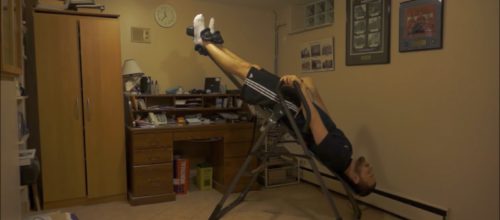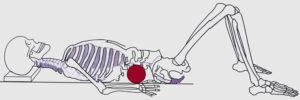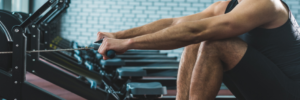
How Long Should One Be Inverted For? My Thoughts and Opinions
Hey, how’s it going everybody? Hope you’re all having a fantastic day today.
With today’s new post, what I wanted to do is do a follow-up post to my previous article and video in which I talked about inversion/traction therapy for people with lower back pain. In that article and video, I explained how inversion/traction therapy could be beneficial for people with lower back pain. However, at the same time, I explained how it might not be helpful for everybody, and it could cause some issues for people with lower back pain if they’re not careful or don’t respond well to traction (e.g., unstable disc or joints). If you didn’t read my previous article or watched my previous video, you may want to start their first before continuing with this post.
Now that you have caught up with things, we can get to the purpose of today’s article, in which I wanted to talk about something a little bit different, and a little bit more precise with regards to inversion therapy. In my previous video, I got asked two critical questions from a subscriber of mine, and I wanted to highlight them in this article.
- How long do you recommend being inverted for?
- What is a therapeutic length would you say?
So to answer these two questions.
In my opinion, it’s going to be different for everybody regarding how long one needs to be upside-down for and also the length or therapeutic length is going to be different for everybody. And the reason I say that is because everyone’s tolerance level is going to be different. Someone that’s not accustomed to hanging upside down may not want to start with a fully tilted inversion table because of the increase in head pressure from the blood flow increases to their head. At the same time they just may not respond to that degree of traction very well, and maybe a more precise level of traction that is much smaller is all that is needed to get benefits. Now, this is just my personal opinion with regards to this, but it’s most important to look at what some of the research says as well.
In one of the early studies looking at the physiological effects of hanging upside down Klatz, Goldman, Tarr, & Pinchuk (1983) looked at the effects of inversion therapy using gravity boots in healthy male (18) and female (2) subjects. Subjects were required to hang upside down at a 90-degree angle for 3 minutes and systolic retinal arterial pressure, diastolic retinal arterial pressure and intraocular pressure were measured after 3 minutes of inversion and compared to resting values. The researchers reported that there was a statistically significant increase in intraocular pressure, systolic retinal arterial pressure, and diastolic retinal arterial pressure when compared to resting values.
The important takeaway here is that because the researchers found an increase in systolic, diastolic and intraocular pressure, the researcher reported that this could pose a problem for people with glaucoma, hypertension or some cardiovascular problems. So people in this population may need to be careful using this type of device or hanging upside down for that period. However, another important takeaway is that this ‘kind’ of gives us a baseline for what may be safe and tolerable for individuals that are healthy (3 minutes roughly).
Also, just to expand on that previous study, there was also a previous report done by Nosse (1978), in which the researcher showed that being in an inverted position increased the spinal length and reduced EMG activity of the para-spinal lumbar musculature in healthy male subjects. More importantly, Noose found that a minimum inversion time of 70 seconds was needed to achieve the maximum effect of the inverted position on the lumbar musculature.
So from Noose’s research, what we see here is that it seems about a minimum of 70 seconds may-be needed for individuals to achieve the maximal effects of inversion therapy on the lumbar musculature.
Lastly, I just wanted to touch on one partially contradicting study to Klatz et al., (1983) on inversion therapy and the effects of blood pressure. Vernon, Meschino & Naiman (1985) examined the physiological effects of hanging upside down in male and female subjects (average age 22.5 years old) using an inversion chair at 60 degrees. The researchers examined blood pressure and pulse rates after 3 minutes of being inverted and found no significant difference in comparison to resting values. These findings contradict the results Klatz found, but it is important to note that the inversion chair requires a person to be seated (hip angle changes) and the degree of inversion was only 60 degrees in comparison to 90 degrees. Ultimately, while these results do contradict Klatz and colleagues, you don’t see many people using an inversion chair, to begin with. Instead, many people are using inversion tables and hanging directly upside down, and from speaking from my own experience, one may feel some discomfort with regards to the increase blood flow and pressure to their head. Something that one may need to be careful with, but also going off the results from Noose, it seems that a minimum of 70 seconds is needed to achieve maximal results in reducing para-spinal lumbar musculature.
With these research findings and based on my own opinion, I believe that the length of time one would want to hang upside down for is about 1-3 minutes. Although, do keep in mind that the degree that you’re going to be hanging at, whether that’s 180 degrees, 90 degrees, 115 degrees are all going to have a significant impact as well because you’re going to be creating more traction with a greater inversion. Moreover, with a greater inversion, you’re also going to be creating more pressure and more blood flow to the individual’s head, which could potentially cause problems in some individuals.
Moreover, if we’re looking at things from the clinical perspective, precision is probably one of the most important things in determining how many degrees of traction one needs and the length of time. And that would be best determined by the clinician or if you are someone may be doing your self rehab, determining what works best for you would be important, and that would be different for every person!
So that’s all I wanted to explain in this article. And just to clarify if anyone is wondering how long you should be inverted for or what the appropriate therapeutic length may be and it will be different for everybody, and everyone’s going to be affected differently in what they need. However, there seems to be a sweet spot of about 1-3 minutes for individuals to get the maximum benefits without causing any potential side effects.
Cheers,
Remi











